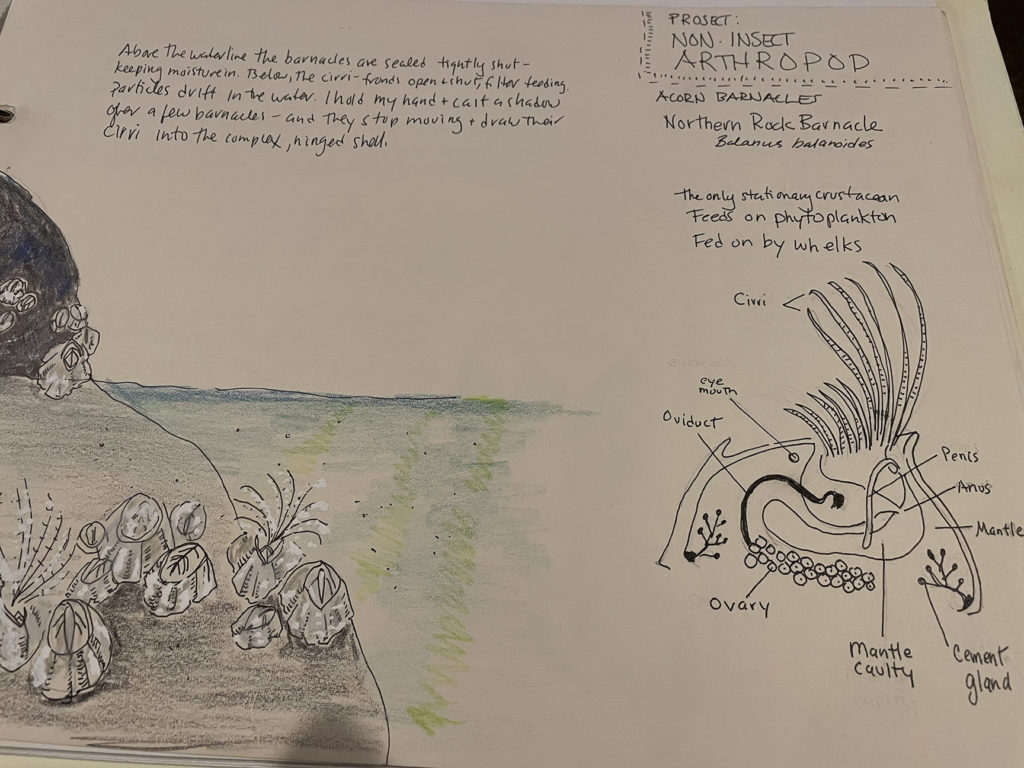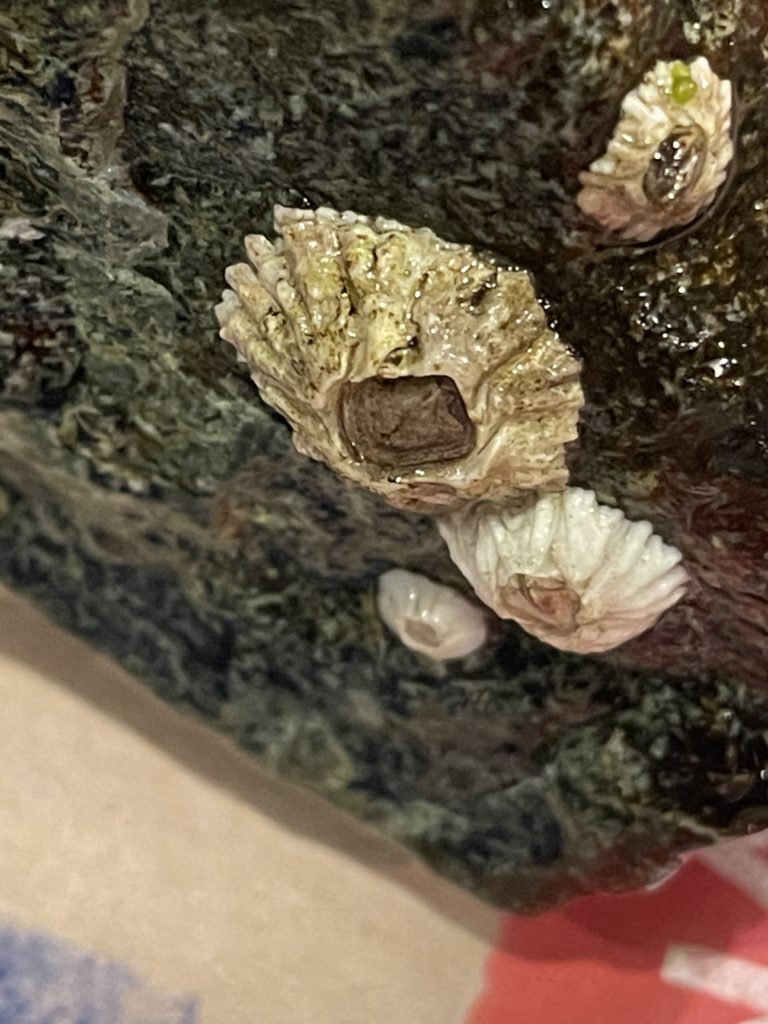Do you look up when you walk, like my hiking pal who is always on the watch for a bird, or towards the ground as I do, scanning for crawling things, tiny growing things, and perhaps, when near the sea, barnacles?

Barnacles are easy to find, unlike giant silk moth cocoons, or a frozen wood frog in leaf litter, which I am always hopeful of discovering. There was a time I cursed barnacles. I had, in a burst of exuberance, leaped into the sea from a rocky ledge. I did have the foresight to make sure I would be able to climb back out onto the rocks but failed to take note of all the barnacles on those rocks. Thin red scratches across the front of my thighs and the inside of my upper arms getting sprayed with salty water was a painful lesson about the power of barnacles. Seemingly innocuous, they should not be ignored.
These days I lie on my belly, although not on barnacle-encrusted rock, to peer into tide pools and watch the mesmerizing way barnacles feed. They have hard, calcareous plates which form the operculum. Like the operculum of a snail, this can close tightly, which is very helpful for retaining moisture when the barnacles are left high and dry at low tide. But when they are underwater, these open and close, allowing six pairs of feathery cirri to rhythmically unfurl and re-curl, coming in and out of their volcano-shaped shelter. There are six types and patterns of this unfurling, and since I no longer take barnacles for granted I watch to see these patterns. Charles Darwin went far deeper with his barnacle obsession, writing about them on a daily basis for eight years from 1846 to 1854. He even named a barnacle, a burrowing barnacle he discovered while aboard the HMS Beagle. (For an informative and entertaining account of Darwin and barnacles, read Sam Kean’s article Darwin’s Barnacles.)

Darwin named his barnacle “Mr. Arthrobalanus.” Having a rock with unique and individual barnacles I look at daily I can understand the temptation to name them. Barnacles are hermaphrodites, containing both male and female sex organs, so gender-neutral names are in order. On my rock little Jaime is pressed tightly against a much larger barnacle, Marin. I know when they return to the shore if Jaime avoids being eaten by a whelk or seastar it will outlive Marin. Whoever lives longer, neither Jaime nor Marin will care that they had names.

The common rock barnacles in Maine, Semibalanus balanoides live up to eight years, but they are rarely larger than half an inch. I eye the larger ones and contemplate dining on them, but they are just too small. I save that treat for visiting the Azores, where barnacles can grow up to two or two-and-a-half inches. My husband and I ate them on a visit to Terceira in 2016, where they were served with a nail for prying out the edible portion. A return visit in 2022 found them still on the menu, and still served with a nail.
Darwin spent eight years studying barnacles, I have maybe a month in. I do not want to spend eight years topping my aquarium with fresh salt water and exchanging strong, wide Marin for an unknown barnacle. I just want to revel in the joy I have learning about them, and bore my friends with barnacle facts. When a mother barnacle releases her young to the sea, they are called nauplii. They are self-propelled larvae and can travel as far as ten kilometers. They molt numerous times, eventually metamorphosing into a cyprid. This is the last stage at which a barnacle can roam. It no longer eats, and simply searches for a forever home. Once it finds it, usually near other barnacles, it plants its head on the rock, secretes a brown glue to hold it there, and builds a dome-shaped home of six stationary plates, and four to form the operculum.
The glue is so strong that when the animal dies, the base shell is still glued to the rock. Yes, this is being studied, we could probably use this glue.
The barnacle will never move from that spot again. But adventure is not over. Barnacles are cemented close to other barnacles, and this is so they can reproduce. Every barnacle has both eggs, and a penis. The penis is up to eight times the length of the barnacle and has a tip that can taste and smell, and poke into the cases of neighboring barnacles to find ripe eggs. When it finds them, it sends in sperm to fertilize them, then discards its penis–it can grow a new one.

The fertilized eggs are kept safe in the hard-plated home the barnacle has made until it is time to send them forth on their own adventures.
Thirty-odd years ago barnacles drew attention to themselves by scraping my skin, and it took that long to circle back and get to know them a little. Actually, to become a bit obsessed. I just ordered Darwin and the Barnacle: The Story of One Tiny Creature and History’s Most Spectacular Scientific Breakthrough by Rebecca Stott. Not sure I am ready for Darwin’s monographs recording eight years of barnacle observations.
Next time you are in barnacle country, take the time to crouch down and look. Can you see the operculum? Can you see the tiny ones and the old ones? I have yet to see nauplii and cyprids, except on the internet. But I have a microscope and time, and cannot think of a better way to spend the day.

